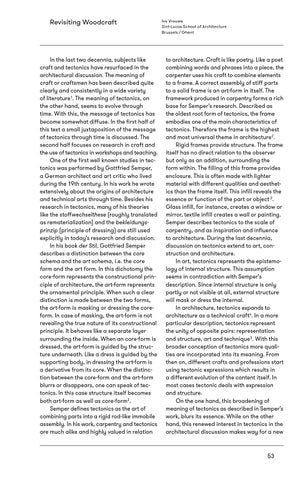Revisiting Woodcraft
In the last two decennia, subjects like craft and tectonics have resurfaced in the architectural discussion. The meaning of craft or craftsmen has been described quite clearly and consistently in a wide variety of literature 1. The meaning of tectonics, on the other hand, seems to evolve through time. With this, the message of tectonics has become somewhat diffuse. In the first half of this text a small juxtaposition of the message of tectonics through time is discussed. The second half focuses on research in craft and the use of tectonics in workshops and teaching. One of the first well known studies in tectonics was performed by Gottfried Semper, a German architect and art critic who lived during the 19th century. In his work he wrote extensively about the origins of architecture and technical arts through time. Besides his research in tectonics, many of his theories like the stoffwechselthese (roughly translated as rematerialization) and the bekleidungsprinzip (principle of dressing) are still used explicitly in today’s research and discussion. In his book der Stil, Gottfried Semper describes a distinction between the core schema and the art schema, i.e. the core form and the art form. In this dichotomy the core-form represents the constructional principle of architecture, the art-form represents the ornamental principle. When such a clear distinction is made between the two forms, the art-form is masking or dressing the coreform. In case of masking, the art-form is not revealing the true nature of its constructional principle. It behaves like a separate layer surrounding the inside. When an core-form is dressed, the art-form is guided by the structure underneath. Like a dress is guided by the supporting body, in dressing the art-form is a derivative from its core. When the distinction between the core-form and the art-form blurrs or disappears, one can speak of tectonics. In this case structure itself becomes both art-form as well as core-form 2. Semper defines tectonics as the art of combining parts into a rigid rod-like immobile assembly. In his work, carpentry and tectonics are much alike and highly valued in relation
Ivo Vrouwe Sint-Lucas School of Architecture Brussels / Ghent
to architecture. Craft is like poetry. Like a poet combining words and phrases into a piece, the carpenter uses his craft to combine elements to a frame. A correct assembly of stiff parts to a solid frame is an art-form in itself. The framework produced in carpentry forms a rich base for Semper’s research. Described as the oldest root form of tectonics, the frame embodies one of the main characteristics of tectonics. Therefore the frame is the highest and most universal theme in architecture 2. Rigid frames provide structure. The frame itself has no direct relation to the observer but only as an addition, surrounding the form within. The filling of this frame provides enclosure. This is often made with lighter material with different qualities and aesthetics than the frame itself. This infill reveals the essence or function of the part or object 2. Glass infill, for instance, creates a window or mirror, textile infill creates a wall or painting. Semper describes tectonics to the scale of carpentry, and as inspiration and influence to architecture. During the last decennia, discussion on tectonics extend to art, construction and architecture. In art, tectonics represents the epistemo logy of internal structure. This assumption seems in contradiction with Semper’s description. Since internal structure is only partly or not visible at all, external structure will mask or dress the internal. In architecture, tectonics expands to architecture as a technical craft 4. In a more particular description, tectonics represent the unity of opposite pairs: representation and structure, art and technique 3. With this broader conception of tectonics more qualities are incorporated into its meaning. From then on, different crafts and professions start using tectonic expressions which results in a different evolution of the content itself. In most cases tectonic deals with expression and structure. On the one hand, this broadening of meaning of tectonics as described in Semper’s work, blurs its essence. While on the other hand, this renewed interest in tectonics in the architectural discussion makes way for a new
53
